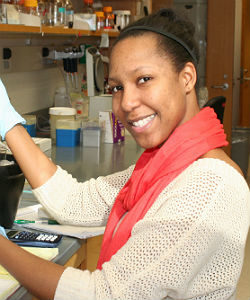
Cheryl Law, Ph.D.
Department: Biochemistry, 2019
Faculty Mentor: Charles Sanders, Ph.D.
Dissertation Title: NMR Resonance Assignments and Secondary Structure of a Mutant Form of the Human KCNE1 Channel Accessory Protein that Exhibits KCNE3-like Function
Dissertation Abstract: KCNQ1 (Q1), a voltage-gated potassium channel, is modulated by members of the KCNE family, the best-characterized being KCNE1 (E1) and KCNE3 (E3). The Q1/E1 complex generates a channel with delayed activation and increased conductance. This complex is expressed in cardiomyocytes where it provides the IKs current, which is critical for the repolarization phase of the cardiac action potential. The Q1/E3 complex, on the other hand, is expressed in epithelial cells of the colon and stomach, where it serves as a constitutively active “leak” channel to contribute to water and ion homeostasis. Studies show the single transmembrane segments (TMS) present in E1 and E3 are essential to their distinct functions. More specifically, residues FTL located near the middle of the E1 TMS are essential for the delayed activation of Q1, while TVG in E3 are critical for constitutive activation of the channel. Swapping these three residues leads to the switching of the functional properties of both Q1/E1FTL→TVG and Q1/E3TVG→FTL complexes. This work details backbone assignments and chemical shifts for the E1FTL→TVG mutant, as determined using a suite of 3D NMR experiments along with specific and inverse amino acid isotopic labeling. The completed assignments are being used, in conjunction with other NMR experiments, to generate a 3D structure of E1FTL→TVG. The results of TALOS-N analysis of the chemical shifts are reported here. The E1FTL→TVG structure will be compared to the already available E1 and E3 structures to determine the roles that their TMS triplet motifs play in each protein to dictate their distinct channel-modulatory functions. KCNE1 and E1FTL→TVG show interesting helical changes within the transmembrane region not seen in KCNE3 yet further structural studies are needed to better understand this critical transmembrane region.
